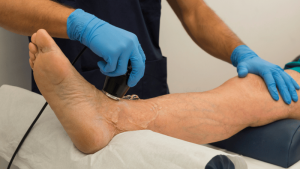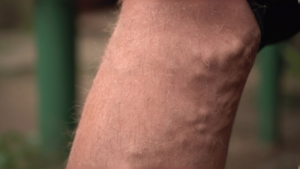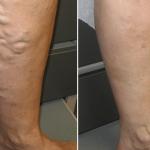
Have you been experiencing leg pain, swelling, or visible veins? A venous ultrasound is a simple, non-invasive test that detects blood clots, poor circulation, and vein disease before complications arise. Whether you’re experiencing symptoms or need a preventive screening, understanding what an ultrasound for leg veins can reveal is key to maintaining healthy circulation.
Early detection through this test can help prevent conditions like ulcers or blood clots. USA Vein Clinics specializes in diagnosing and treating vein conditions while offering personalized care tailored to your needs. If you’re experiencing vein-related symptoms, early detection can help prevent symptoms from progressing.
Assess Your Vein Health – Take the Quiz
What Is a Venous Ultrasound?
A venous ultrasound is a diagnostic test that uses sound waves to visualize blood flow in the veins of the legs. Also known as a Doppler ultrasound or vascular ultrasound, it helps assess circulation, detect blood clots, and diagnose vein disease.
This non-invasive procedure allows doctors to get real-time imaging of blood flow, providing crucial insights into your vein health. By identifying blockages, reflux, or damage to vein valves, a venous ultrasound can help pinpoint issues that may lead to conditions like varicose veins, deep vein thrombosis, or chronic venous insufficiency.
Your doctor may order this exam to:
- Monitor the blood flow to your legs
- Check for blockages or abnormalities
- Detect blood clots, including deep vein thrombosis (DVT)
- Evaluate varicose veins
- Evaluate spider veins
- Map blood vessels to plan vein treatment
- Provide real-time guidance during vein procedures
- Diagnose vein disease
What Does a Venous Ultrasound Show?
Venous ultrasounds use high-frequency sound waves to create detailed images of superficial and deep veins. This can help identify vein disease characteristics or leg vein abnormalities.
Diagnosing Deep Vein Thrombosis (DVT)
A venous ultrasound can detect blood clots caused by DVT, which can be life-threatening if left untreated. Ultrasounds make identifying clots in deep veins accessible, enable healthcare professionals to make early interventions, and help prevent life-threatening complications like pulmonary embolism.
Symptoms of DVT that may require an ultrasound:
- Swelling in one leg: Swelling, especially if it’s only in one leg, can be a sign of poor circulation or a clot.
- Pain or tenderness in the calf or thigh: Pain or tenderness in the lower leg, especially with movement, could indicate vein issues like DVT or chronic venous insufficiency.
- Skin discoloration or warmth in the affected area: Discoloration, often accompanied by warmth, may signal inflammation or impaired circulation in the veins.
Chronic Venous Insufficiency (CVI)
A venous ultrasound helps determine if faulty vein valves are causing poor circulation, swelling, or leg discomfort. It can help determine if varicose or spider veins indicate a deeper vein issue. By providing detailed images of blood flow, the ultrasound helps diagnose CVI and guide appropriate treatment options.
Symptoms of CVI that may require an ultrasound:
- Leg heaviness, fatigue, or cramping: These symptoms often indicate impaired circulation and can be a sign of CVI.
- Visible bulging veins that worsen over time: Bulging veins, particularly varicose veins, that increase in size or cause discomfort could point to CVI.
Evaluating Blood Flow & Circulation Issues
A venous ultrasound measures how efficiently blood flows through the veins. This diagnostic tool is particularly useful in detecting venous reflux or when blood pools in the legs. Venous reflux can cause symptoms like fatigue, heaviness, or cramping.
Symptoms of Poor Circulation:
- Tingling sensation or numbness in the legs: Poor circulation can cause a feeling of tingling or numbness in the lower legs.
- Cold or discolored feet and toes: Reduced blood flow may lead to cold, pale, or bluish feet and toes.
- Slow wound healing on the lower legs: Circulation problems can slow the healing of wounds or ulcers on the legs, indicating a need for medical attention.
If you’re unsure if you’re experiencing circulation issues, seeing a vein specialist for a screening is recommended.
Schedule a Vein Screening Today
When Do You Need a Venous Ultrasound?
If you’re experiencing ongoing leg pain, swelling, or circulation issues, a venous ultrasound can help detect underlying vein problems. Your doctor may recommend this test to evaluate blood flow, detect clots, or diagnose vein disease. This test may enable early intervention and effective treatment for improved circulation and overall health.
Symptoms That May Require a Leg Ultrasound
- Leg swelling, cramping, or discomfort: These symptoms can indicate vein-related issues, such as poor circulation or blood clots, that a venous ultrasound can help identify.
- Visible veins that worsen over time: If varicose or spider veins increase in size or discomfort, an ultrasound can assess underlying causes, like venous reflux or valve dysfunction.
- Skin discoloration or slow-healing wounds: Discoloration or wounds that don’t heal properly may signal circulation problems that require attention from a medical professional.
Preventative Screening for At-Risk Individuals
- Personal or family history of varicose veins: A history of varicose veins increases the likelihood of developing similar vein issues, making a venous ultrasound a valuable preventive measure.
- Previous blood clots (DVT) or circulation issues: If you’ve had blood clots or prior circulation problems, regular ultrasounds can help monitor your vein health and prevent recurrence.
- People who sit or stand for long periods: Sitting or standing for extended intervals can increase the risk of vein problems, so an ultrasound may help detect early signs of venous insufficiency.
Is a Vein Ultrasound Safe?
A venous ultrasound is considered a safe, non-invasive diagnostic procedure. Doctors use the same technology to monitor a growing fetus in the womb, so there are no injections or radiation involved.
How to Prepare for a Venous Ultrasound
Although no special requirements are needed before a vein ultrasound, wearing comfortable, loose clothing is recommended, and avoid wearing jewelry. It’s also important to communicate with your healthcare provider beforehand to address any concerns or additional preparations specific to your needs, such as medications or other health conditions.
What to Expect During The Leg Ultrasound Exam
Your ultrasound technician will begin by applying gel on the skin, which may feel cool initially. They will then use a handheld device called a transducer to obtain real-time imaging of your leg veins for evaluation. Your images appear on a small screen, depending on your positioning. You may be asked to change positions during your exam.
What to Expect After The Leg Ultrasound Exam
After the exam, you will be given a towel to wipe off any residual gel from your skin. You can then change back into your regular clothing.
Your doctor will make personalized treatment recommendations based on your ultrasound findings to best fit your needs.
What Happens if Your Ultrasound Shows Vein Disease?
A venous ultrasound is a crucial first step in diagnosing circulatory issues, blood clots, and vein disease. This non-invasive procedure provides detailed images of the veins, allowing specialists to identify blockages, valve dysfunction, and other issues.
USA Vein Clinics experts use state-of-the-art ultrasound technology to assess your vein health thoroughly. Getting timely results can help determine your best course of action, ensuring a personalized and effective approach to improving circulation and alleviating symptoms.
Schedule Your Vein Screening Now
Treatment Options After a Venous Ultrasound Diagnosis
After a diagnosis, you may need vein treatment depending on your results. USA Vein Clinics offers quick, effective, and minimally–invasive treatments that require little downtime, allowing for a faster recovery and better health outcomes.
Our vein treatments include:
- ClariVein®: A rotating fiber device seals damaged veins to reroute blood flow.
- VenaSeal™: A specialized medical adhesive is injected into the vein to seal it off.
- Varithena foam treatment: This procedure uses a foam solution to fill and collapse damaged veins.
- Radiofrequency Ablation: Heat is used to close damaged veins in this treatment.
- Ultrasound-Guided Sclerotherapy: A solution is injected to collapse damaged veins and reroute blood flow.
- Endovenous Laser Vein Treatment: A laser is used to heat and seal weak veins
- Sclerotherapy: A sclerosant solution is used to collapse damaged veins.
Identify Vein Disease Early with a Venous Ultrasound
If you’ve been experiencing leg pain, swelling, or visible veins, a venous ultrasound at USA Vein Clinics can help you understand why you experience these symptoms and what can be done to resolve them. Early detection of vein disease leads to better outcomes, meaning your circulation improves, your varicose veins disappear, and your legs can feel lighter.
USA Vein Clinics specializes in diagnosing and treating vein disease with advanced, minimally invasive outpatient treatments designed to restore healthy circulation and improve overall quality of life. With nationwide locations, we make getting the care you need easier than ever, accepting most insurance plans, including Medicare and Medicaid.
Scheduling your consultation is simple and convenient. Book online or call 888.768.3467 today.









